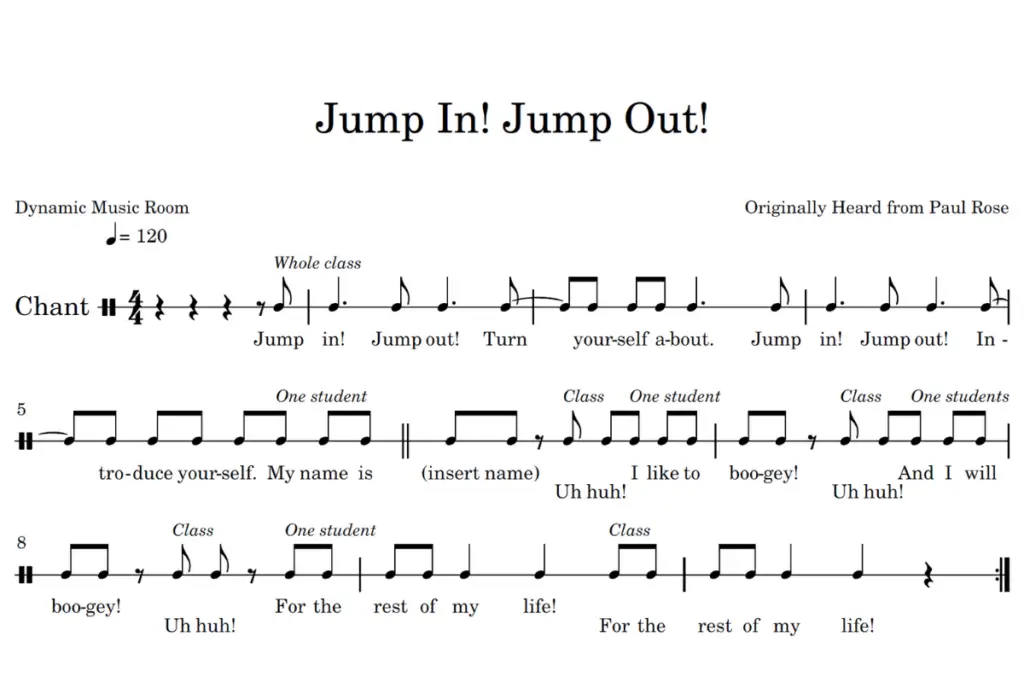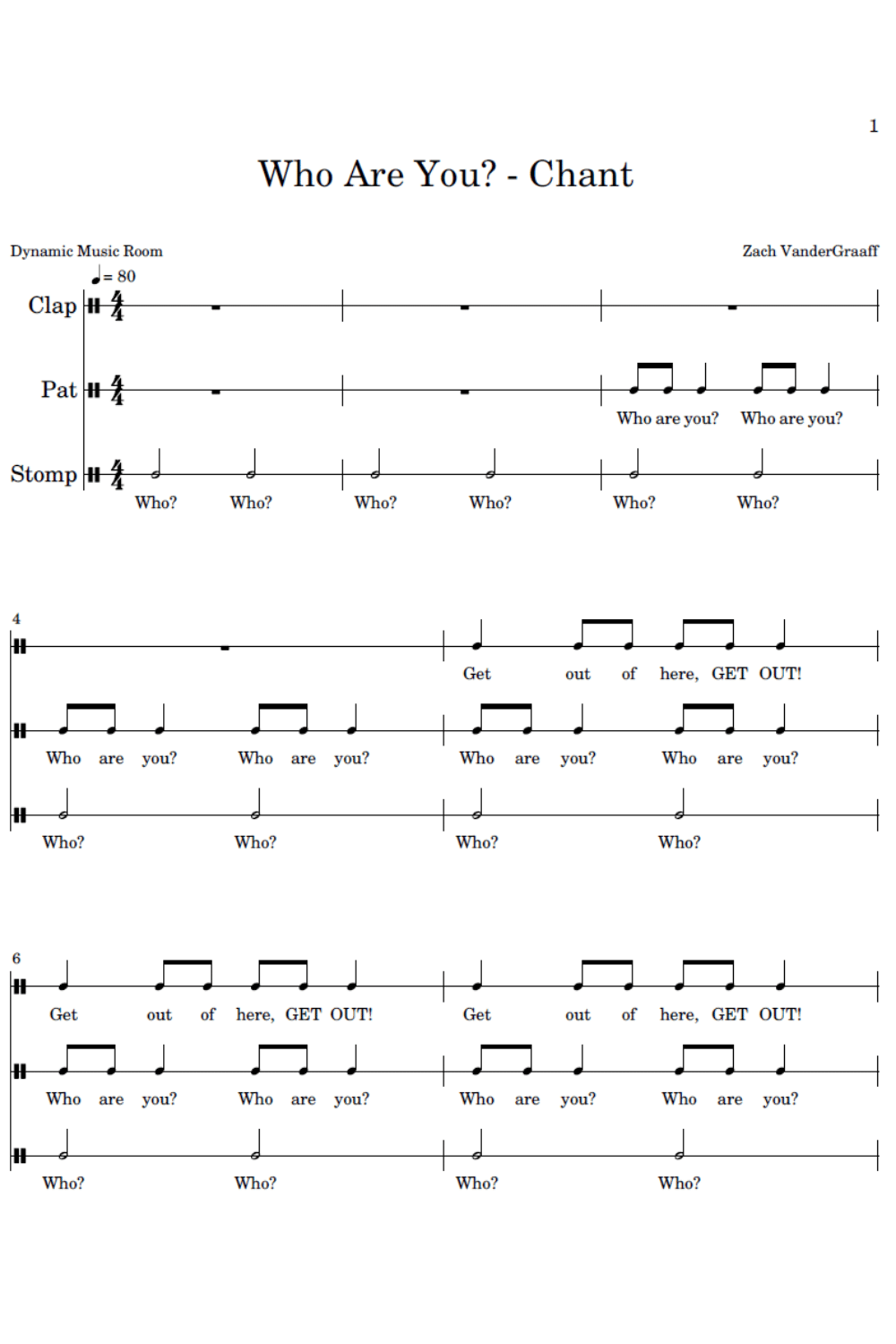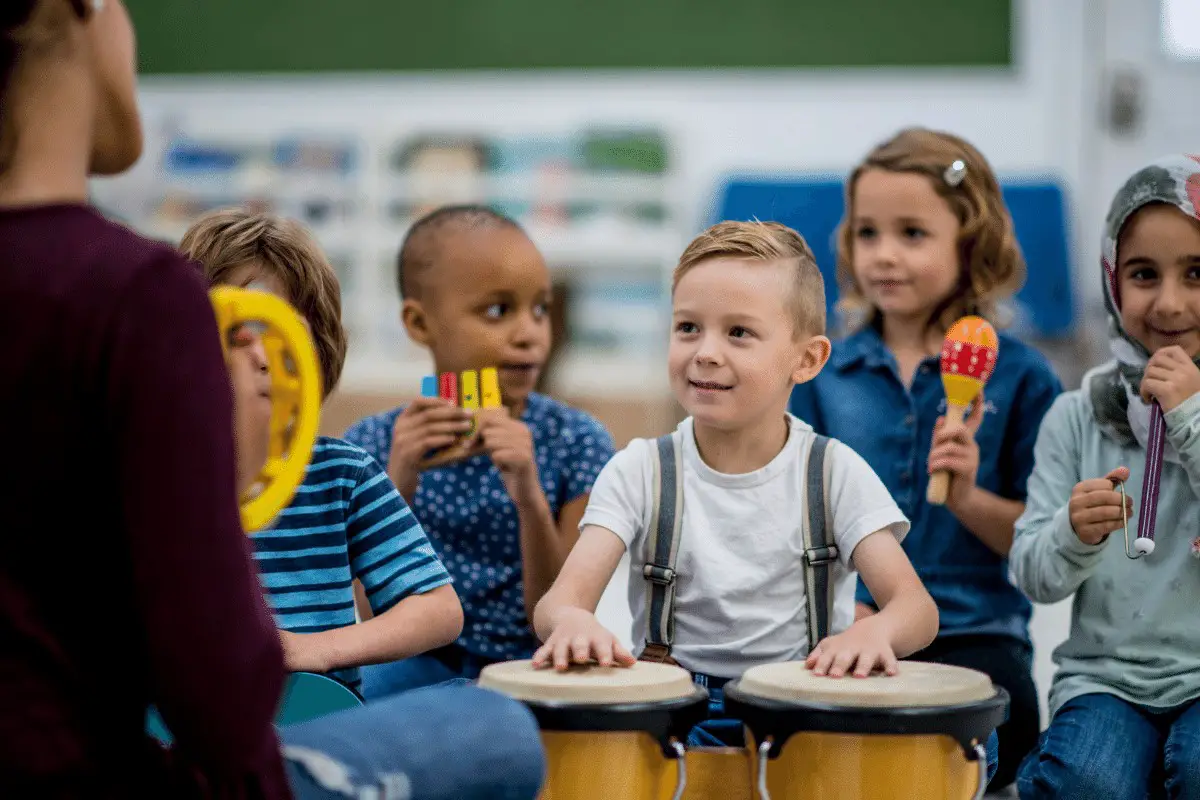I’ve taught for over a decade now, and every year I know every music teacher gets a little excited and nervous for the new year.
New teachers and student teachers feel this even more than experienced teachers do, and rightfully so.
The first day of classes is critical for making sure the year gets off on the right foot in many ways, including:
- Building relationships with students
- Setting up classroom management
- Establishing music classroom procedures for more efficient learning later on
- Setting the tone for a safe space
- Providing a fun and engaging musical experience
It’s a tall order and one that stresses a lot of people out, which is why I wanted to share with you my 9 favorite first day of music class ideas to get your room started right.
Table of Contents
#1 Name Games
There’s no better activity to put into your first day of school or first week of school than names games.
Many of them are musical, so they get the students to make music, which is critical early. You want them to know your class is an active place.
On top of this, it helps show them you care enough to try and learn student names.
I’m quite bad at learning and remembering the names of my 600+ students, and I know I don’t even have a lot compared to other elementary music teachers.
Name games at the beginning helped me out a ton!
Here’s one of my favorite name game chants to do with almost any grade level:

Pro-tip: Be honest with your students about how many students you have and apologize in advance for forgetting their names. It helps ease their hurt if you forget later.
I tell them that my forgetting doesn’t reflect how awesome they are and how much I love teaching them; it’s just my small brain drawing a blank sometimes.
#2 Chant-Time! (Who Are You?)
I want my students to get into music right away, and while the name games help, music is important enough on its own to earn a spot simply for its own sake.
Still, I set my students up for success by choosing simple chants that review concepts they’d learned last year.
One of my favorites is a simple one I made up for middle and older grades. I teach this as a layered ostinati chant, then we add in instruments, and then I facilitate students in choosing a new arrangement.
I usually spread this out over a couple of classes, but we start the first day with the chant and playing some instruments and a drum beat.
Here’s the notation:

For more directions, check out this chant in the article on 5th-grade music lesson plans.
#3 Attention-Getter Challenge
I have a love-hate relationship with attention-getters. The goal is to have a signal or call and response to get the students’ attention when working on other things.
Too often, teachers get really “cutesy” with what they use, and while it looks cool, it doesn’t serve the right purpose. A good one needs:
- A visual piece
- Time for finishing conversations and winding down
- Be followed through after consistently
There are hundreds out there all over teacher Facebook groups. This list is pretty good, but I like to keep it simple with a count-down from 5 or even a triangle strike followed by a descending sol-fa-mi-re-do call and response.
Many people forget that these need to be taught and reinforced right from the first day, so I like to do an attention-getter challenge.
After I teach the sign, I challenge the students to earn three stars by giving them different activities. To earn a star (or whatever you prefer), they have to:
- Respond to the signal.
- Get quiet with eyes on me.
- Stay quiet after the teacher starts talking.
So I’ll have them talk to each other by asking them to randomly share with neighbors things like:
- Favorite color
- Favorite thing that happened this summer
- What they love to do when they’re bored
Then, at differing lengths in their conversations, I give the signal, go through the steps, and review how they did.
Then, we’ll do it again throughout the lesson with other things to earn their stars.
It seems like a lot, but really, it only takes 3-4 minutes in the whole lesson.
#4 My Three Favorites (Get To Know You; Quick)
Get-to-know-you games are awesome! We have so little time with our kids anyway; it’s important to spend some time at the beginning showing you do care about them.
One of my favorite quick of these is what I call “My Three Favorites.”
It’s not even a game; it’s just a prompt.
I split kids into groups of 3-4 and ask them to share the big 3 favorites everyone has:
- Favorite food
- Favorite animal
- Favorite movie or show
I share first to let them know and then ask them to share. This pairs well with practicing the attention-getter and can be part of the last idea of challenging them.
As someone who loves cooperative learning, this is a great way to set this up for kids.
Click the link to learn more in my guide on cooperative learning in music.
Pro-tip: Make sure you circulate and listen in on the groups and occasionally comment to show you’re paying attention and help with the management.
#5 Instrument/Classroom Procedures
It’s not flashy and cool, but setting up management expectations and procedures is essential right from the first day.
I’d say most of the time there’s a problem with behavior in a classroom, it’s because a procedure or expectation wasn’t set up or isn’t being followed through with consistency.
I say “most of the time,” but we all know there are kids who bring other issues outside the classroom that always break these expectations.
But if you have it set up well where all the kids follow it, the other ones won’t break them quite as much.
I follow and love the steps from the book, The First Days Of School (this is an affiliate link to Amazon, but I seriously review this every year; it’s so good!).
They talk about the importance of teaching-modeling-practicing-revisiting all procedures.
Keep them posted visually and re-teach as needed. It seems like a waste of time, but you’ll save so much more time in the long run.
#6 Move To Music (Hungarian Dance No. 5)
Often, you won’t be able to get into more advanced music on the first day. If you can, you’re a rock star and taught them so well in past years!
I love to include some kind of fun movement to classical music. The key here is fun and engaging.
One of my go-to’s is the Hungarian Dance No. 5 and what I call the “computer game.”
This works great for younger kids, but once I teach it, my students ask for it into fifth grade.
Here’s how you play:
- Students are spread out around the room, pretending to work on invisible computers.
- You, the “boss,” have to watch them as they work.
- When the boss turns around, the workers dance and celebrate in their work areas.
- When the boss turns back around, the workers go back to working on their computers.
- Align when you turn away to match the faster parts of the song. Align when you turn back to match the slower or quieter parts.
I also add funny faces and different goofy things. This song works well with this type of activity, but others will work too.
Here’s the version I listen to:
#7 Five Fingers (Get To Know You; Advanced)
This is another get-to-know-you activity not related to music. Normally, I like to keep things music-focused, but it’s important to build those class relationships in the first few days.
This one takes a bit more time and requires more thought on the students’ parts. As such, I usually leave it for the older grades.
It’s based around a simple five questions, one for each finger on your hand. Students think about their answers and then share in small groups.
- Thumb: What are you good at?
- Index finger: What’s one thing you would like to do in life?
- Middle finger: What’s something you don’t like?
- Ring finger: What’s something you like?
- Little finger/Pinky finger: What’s something people don’t know about you?
As always, with group work, set clear expectations, model appropriately, and give feedback on how well they’re sharing and what they can do better.
Here are mine if you’re curious!
- I’m good at making projects with wood!
- I’d love to visit some distilleries in Scotland.
- I don’t like French Toast.
- I love reading mysteries.
- I’m the oldest of 8 kids in my family!
#8 Seating Chart
I wish all first-day ideas could be fun, but it’s just not meant to be.
I haven’t always bought into the idea of a seating chart, but sometimes it just makes life easier.
You don’t want to spend a ton of time on this. Usually, I make one based on the alphabetical order of the class.
This usually works to mix things up and avoid cliques forming.
If the classroom teacher has a similar setup to my room, I’ll ask to use theirs as a reference.
Any time you can take away the mystery or a source of unease with the kids, you make them feel safer. We don’t stay in these assigned seats the whole class or the whole year, but it’s quite helpful for the start of the year.
#9 Your Summer Fun (With Music)
Anytime in the beginning you can combine music with sharing, it’s awesome!
Usually, I’m picky about the folk songs I use. I want real ones, not made-up ones, even if they’re made up by music teachers.
There are so many great ones; it seems a shame not to use more authentic ones. But in the beginning, if it helps gets the year started right, why not use it?
Here is a simple song I use lower el.

With the younger ones, I’ll have them play on a drum while they sing their answer. They don’t have to worry about steady beat or rhythm. I’m not picky at this point.
And it’s an echo song which is super easy on the first day!

